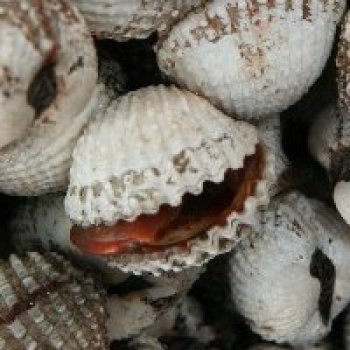Blood Clam
Category: Clam

Facts about Blood Clams, "Scientific name for Blood Clam is Anadara granosa". Blood Clams are a variety of ark clam that belongs to the genus Anadara of the Arcidae family. The scientific name of this clam variety is Anadara granosa. These clams are recognized as the blood cockle, owing to the red hemoglobin liquid in their body. They are largely found all through the Indo-Pacific area, ranging from the northeastern coastline of South Africa and the eastern parts of Southeast Asia, Polynesia, Australia, and up to the northern parts of Japan. They usually prefer to live in the intertidal region at a depth of one to two meters, burrowed down into the mud or sand. These clams have a high economic cost for food, and they are kept in aquaculture. Just on the coastline of Zhejiang Province only, the plantations of Blood Clams occupy approximately 145,000 minor units (100 square kilometers) of sludge flats. They are also raised in the waterway estuaries of the adjacent Fujian Province. This clam variety is served boiled, steamed, roasted, or usually uncooked.
Features of Blood Clams
Adult Blood Clams can grow to a maximum length between 2 inches and 2.4 inches (5 cm and 6 cm), with a breadth that ranges from 1.6 inches to 2 inches (4 cm to 5 cm).
Blood Clams have an equivalve oval-shaped shell, which is strong and thick. It is powerfully inflated, somewhat longer than elevated and feebly inequilateral. They have strong protruding umbones, and a large cardinal area. They have 18 radial ribs, with broad interstices at every valve. The ribs of these clams are stout and noticeably rugose, bearing normal, habitually rectangular nodules. Usually, these clams have yellowish brown color periostracum, which is somewhat thin and smooth. They have the internal margins, with physically powerful crenulations analogous with the outside radial ribs. These clams have no byssal gape and the color of their outside shell is white under the periostracum. The inner side of the shell is also white in color, but it is habitually hinted with light yellow color towards the umbonal hole.
Blood clams are commonly found in the Indo-West Pacific, ranging from the eastern parts of Africa to Polynesia. They can also be seen in abundance in the northern parts of Japan and the southern to northeastern parts of Australia.
Diet of Blood Clam
Blood clams mostly feed on detritus, unicellular algae and phytoplankton.
Behavior of Blood Clam
Generally, Blood clams prefer to live at a depth of 20 meters, but they will concentrate in the littoral region, where the land will be in dry condition for 6 to 10 hours per day and night. They are typically intertidal clam varieties that naturally live in a region of salty bottom with moderately low salinity and occasionally with aridness while ebbing every day.
Generally, Blood clams are filter feeders and shallow burrowers. Their nourishing habit is associated with the bottom nourish where they exist. Their significant nutrients components include organic detritus of which 98% can be found in the intestine of a Blood clam.
The mating season in Blood clams starts from August and continues until February of the subsequent year. Both male and female Blood clams attain sexual maturity after 1 or 2 years of their birth. The female clam is capable of producing 518,400 to 2,313,200 eggs during each breeding cycle. They can be adjusted to salinity of 14 to 300 and with the temperature, ranging from 20 degrees Centigrade to 30 degrees Centigrade.
The average lifespan of Blood clams ranges from 3 years to 4 years and this may increase, according to the location they live.

 Back To Category Clam
Back To Category Clam